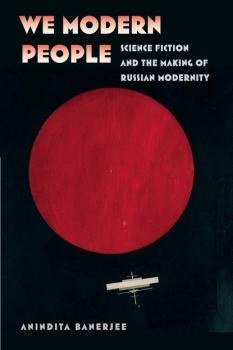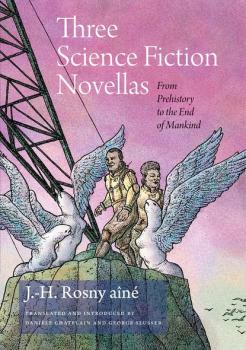ТОП просматриваемых книг сайта:
Early Classics of Science Fiction
Скачать книги из серии Early Classics of Science FictionАннотация
<P>Science fiction emerged in Russia considerably earlier than its English version and instantly became the hallmark of Russian modernity. We Modern People investigates why science fiction appeared here, on the margins of Europe, before the genre had even been named, and what it meant for people who lived under conditions that Leon Trotsky famously described as «combined and uneven development.» Russian science fiction was embraced not only in literary circles and popular culture, but also by scientists, engineers, philosophers, and political visionaries. Anindita Banerjee explores the handful of well-known early practitioners, such as Briusov, Bogdanov, and Zamyatin, within a much larger continuum of new archival material comprised of journalism, scientific papers, popular science texts, advertisements, and independent manifestos on social transformation. In documenting the unusual relationship between Russian science fiction and Russian modernity, this book offers a new critical perspective on the relationship between science, technology, the fictional imagination, and the consciousness of being modern.</P>
Аннотация
<P>To the short list that includes Jules Verne and H.G. Wells as founding fathers of science fiction, the name of the Belgian writer J.-H. Rosny A&#238;n&#233; must be added. He was the first writer to conceive, and attempt to narrate, the workings of aliens and alternate life forms. His fascination with evolutionary scenarios, and long historical vistas, from first man to last man, are important precursors to the myriad cosmic epics of modern science fiction. Until now, his work has been virtually unknown and unavailable in the English-speaking world, but it is crucial for our understanding of the genre. Three wonderfully imaginative novellas are included in this volume. «The Xipehuz» is a prehistoric tale in which the human species battles strange geometric alien life forms. «Another World» is the story of a mysterious being who does not live in the same acoustic and temporal world as humans. «The Death of the Earth» is a scientifically uncompromising Last Man story. The book includes an insightful critical introduction that places Rosny's work within the context of evolutionary biology.</P>
Аннотация
<P>For centuries, the planet Mars has captivated astronomers and inspired writers of all genres. Whether imagined as the symbol of the bloody god of war, the cradle of an alien species, or a possible new home for human civilization, our closest planetary neighbor has played a central role in how we think about ourselves in the universe. From Galileo to Kim Stanley Robinson, Robert Crossley traces the history of our fascination with the red planet as it has evolved in literature both fictional and scientific. Crossley focuses specifically on the interplay between scientific discovery and literary invention, exploring how writers throughout the ages have tried to assimilate or resist new planetary knowledge. Covering texts from the 1600s to the present, from the obscure to the classic, Crossley shows how writing about Mars has reflected the desires and social controversies of each era. This astute and elegant study is perfect for science fiction fans and readers of popular science.</P>
Аннотация
<P>For nearly half a century, feminist scholars, writers, and fans have successfully challenged the notion that science fiction is all about «boys and their toys,» pointing to authors such as Mary Shelley, Clare Winger Harris, and Judith Merril as proof that women have always been part of the genre. Continuing this tradition, Sisters of Tomorrow: The First Women of Science Fiction offers readers a comprehensive selection of works by genre luminaries, including author C. L. Moore, artist Margaret Brundage, and others who were well known in their day, including poet Julia Boynton Green, science journalist L. Taylor Hansen, and editor Mary Gnaedinger. Providing insightful commentary and context, this anthology documents how women in the early twentieth century contributed to the pulp-magazine community and showcases the content they produced, including short stories, editorial work, illustrations, poetry, and science journalism. Yaszek and Sharp's critical annotation and author biographies link women's work in the early science fiction community to larger patterns of feminine literary and cultural production in turn-of-the-twentieth-century America. In a concluding essay, the award-winning author Kathleen Ann Goonan considers such work in relation to the history of women in science and engineering and to the contemporary science fiction community itself.</P>
Аннотация
<P>Challenging assumptions about science fiction's Western origins, Nathaniel Isaacson traces the development of the genre in China, from the late Qing Dynasty through the New Culture Movement. Through careful examination of a wide range of visual and print media—including historical accounts of the institutionalization of science, pictorial representations of technological innovations, and a number of novels and short stories—Isaacson makes a case for understanding Chinese science fiction as a product of colonial modernity. By situating the genre's emergence in the transnational traffic of ideas and material culture engendered by the presence of colonial powers in China's economic and political centers, Celestial Empires explores the relationship between science fiction and Orientalist discourse. In doing so it offers an innovative approach to the study of both vernacular writing in twentieth-century China and science fiction in a global context.</P><P><B>Hardcover is un-jacketed.</B></P>
Аннотация
<P>The genre of prehistoric fiction contains a surprisingly large and diverse group of fictional works by American, British, and French writers from the late nineteenth century to the present that describe prehistoric humans. Nicholas Ruddick explains why prehistoric fiction could not come into being until after the acceptance of Charles Darwin's theories, and argues that many early prehistoric fiction works are still worth reading even though the science upon which they are based is now outdated. Exploring the history and evolution of the genre, Ruddick shows how prehistoric fiction can offer fascinating insights into the possible origins of human nature, sexuality, racial distinctions, language, religion, and art. The book includes discussions of well-known prehistoric fiction by H.G. Wells, Jules Verne, J.-H. Rosny A&#238;n&#233;, Jack London, William Golding, Arthur C. Clarke, and Jean M. Auel and reminds us of some unjustly forgotten landmarks of prehistoric fiction. It also briefly covers such topics as the recent boom in prehistoric romance, notable prehistoric fiction for children and young adults, and the most entertaining movies featuring prehistoric humans. The book includes illustrations that trace the changing popular images of cave men and women over the past 150 years.</P>
Информация о книге
Автор произведения Nicholas Ruddick
Аннотация
<P>At the Weldon Institute in Philadelphia, a mob of zealous balloon enthusiasts plans to conquer the sky in a state-of-the-art dirigible. When a stranger, the mysterious Robur, declares that the future belongs not to balloons but to heavier-than-air flying machines, the Institute scornfully dismisses the idea. But Robur demands vengeance—and has a unique flying machine that will allow him to take it.</P><P>By turns an impassioned argument for aviation, a wild proto-steampunk adventure, and a jubilant celebration of the dream of flight, Robur the Conqueror ranks among Jules Verne's most iconic and influential works. Its technological speculations, including the unforgettable aircraft Albatross, are a vibrant snapshot of nineteenth-century scientific innovation. </P><P>This, the first complete English translation of Verne's 1886 novel, includes an insightful introduction, explanatory chapter notes, never-before-published glimpses of Verne's original manuscript, all the first-edition illustrations by L&#233;on Benett, and an up-to-date Verne biography and primary and secondary bibliography. It is an essential new edition of a seminal science fiction classic.</P>
Аннотация
<P>One of the great «first novels» in world literature is now available in a complete, accurate English translation. Prepared by two of America's leading Verne scholars, Frederick Paul Walter and Arthur B. Evans, this edition honors not only Verne's farseeing science, but also his zest, style, and storytelling brilliance. Initially published in 1863, Five Weeks in a Balloon was the first novel in what would become the author's «Extraordinary Voyages» series. It tells the tale of a 4,000-mile balloon trip over the mysterious continent of Africa, a trip that wouldn't actually take place until well into the next century. Fusing adventure, comedy, and science fiction, Five Weeks has all the key ingredients of classic Verne: sly humor and cheeky characters, an innovative scientific invention, a tangled plot that's full of suspense and surprise, and visions of an unknown realm. As part of the Early Classics of Science Fiction series, this critical edition features extensive notes, all the illustrations from the original French edition, and a complete Verne biography and bibliography. Five Weeks in a Balloon will be a prized addition to libraries and science fiction reading lists, and a must-read for Verne fans and steampunk connoisseurs.</P>
Аннотация
<P>Nine students from London's Antillean School receive travel scholarships to visit their island homelands in the Caribbean. Accompanied by their eccentric Latin professor, they set sail on what they expect to be a thrilling educational voyage. Little do they realize that, prior to their arrival on board, their ship had been hijacked by escaped convicts who murdered its original captain and crew. This is the only novel by the legendary Jules Verne that has never been available in English until now. Although ostensibly written for an adolescent audience, its suspense-filled plot, sophisticated narrative style, and critique of European colonialism make it an engrossing read for all ages.</P>
The Emergence of Latin American Science Fiction - Rachel Haywood Ferreira
Early Classics of Science FictionАннотация
<P>Early science fiction has often been associated almost exclusively with Northern industrialized nations. In this groundbreaking exploration of the science fiction written in Latin America prior to 1920, Rachel Haywood Ferreira argues that science fiction has always been a global genre. She traces how and why the genre quickly reached Latin America and analyzes how writers in Argentina, Brazil, and Mexico adapted science fiction to reflect their own realities. Among the texts discussed are one of the first defenses of Darwinism in Latin America, a tale of a time-traveling history book, and a Latin American Frankenstein. Latin American science fiction writers have long been active participants in the sf literary tradition, expanding the limits of the genre and deepening our perception of the role of science and technology in the Latin American imagination. The book includes a chronological bibliography of science fiction published from 1775 to 1920 in all Latin American countries.</P>
Информация о книге
Автор произведения Rachel Haywood Ferreira










